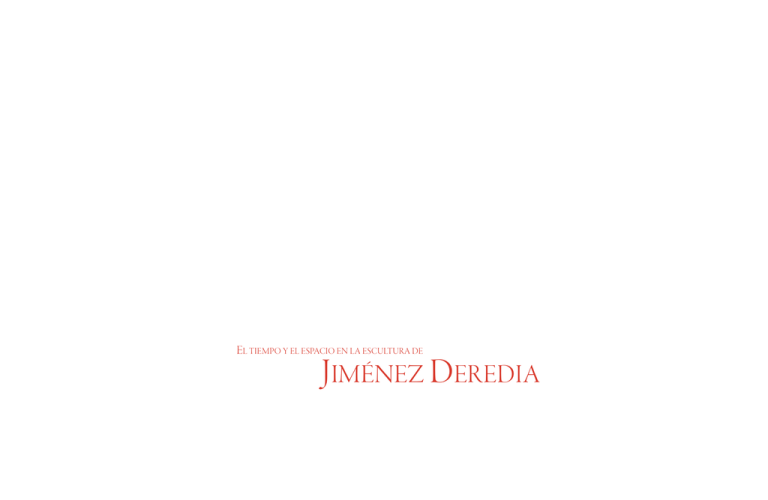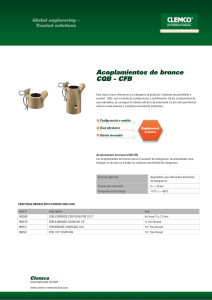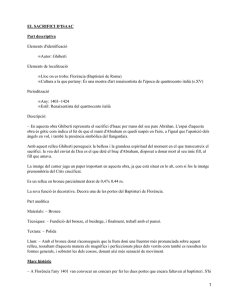PDF - Ascaso Gallery
Anuncio

EL TIEMPO Y EL ESPACIO EN LA ESCULTURA DE JIMÉNEZ DEREDIA P R EGNANT WITH MEANING THE SCULPTUR E OF J IMÉNEZ D ER EDIA GEORGE S. BOLGE CEO, Museum of Art – DeLand, Florida Director Emeritus Nova Southeastern Museum of Art, Fort Lauderdale, Florida Boca Raton Museum of Art, Boca Raton, Florida One of the great problems confronting early 20th century sculpture was that it had no Cezanne upon whom to draw. By that I mean that sculpture lacked the kind of seminal figure that painting, in the first years of this century, had in Paul Cezanne. It was Cezanne, after all – aided to a great extent by Van Gogh and Gauguin, who opened the door to 20th century painting and gave it legitimacy and direction. Auguste Rodin, the last great sculptor of the 19th century was, unfortunately, was just that: a 19th century sculptor whose influence upon this century’s art was, for all practical purposes, nonexistent. If anything, it was against him and his creative philosophy, that most of the innovative sculptors rebelled early in the century. Modernism, both in sculpture and in painting, was generally viewed by early 20th century artists as either a formal truth to be pursued at all costs, or as a huge warehouse of pictorial devices from which the artist could pick and choose whatever seemed appropriate to the creative task at hand. This traditional concern of artistic purity and formal truth became the central issue for the Costa Rican artist, Jimenez Deredia, whose career emerged during the years after WWII. And since perfection and truth in art have usually been associated with simplicity and cohesiveness, and more recently with irreducible form, this artist naturally found himself intrigued by the spherical objects located throughout his homeland using their elemental and primeval form as inspiration for his work. Deredia reduces sculptural form to its basics: to the egg shape; the slab; the box; the ball; the rounded, elliptical shape that resembles a stone worn smooth in a stream; and so on. Utilizing these forms, he conceived sculpture of such simplicity and truth that his achievements contributed significantly to the crucial elements of the formal vocabulary of 21st century Latin American art. This artist’s creative inventiveness is so exceptional that one can almost say that he “wills” his pieces into being. But art is never created in a vacuum. There are always precedents and inspirations for everything in art, no matter how novel or unique such art may at first appear. In Deredia’s case, inspiration and precedent came from several sources: from the history and the cultural tradition of his country, from the indigenous, Pre-Columbian Indian mythologies, from the simplest forms in nature, and from the 3 spirit of European religion and art. He draws from all of these resources, but the most crucial quality about his art comes from within himself – and that is the conviction that the creative concept of sculpture he envisions is not only relevant to the times, but true to the ultimate goals of art as well. In his work, the artist strips subject matter down to its essentials. He distills and compacts the complex into the simple wherever he can, and becomes the great master of “omission,” knowing how to reduce the irrelevant into the relevant. But while his work may appear somewhat abstract, it never really is intended to be. If he is drawn to the perfect shape of a circle, for instance, it is not only for its form, but also because of the mystery and promise the circle contains. Perfect it might be, but one day it may break open, and who knows what might emerge! It is this profound sense of containment, of being based in life, that sets Jimenez Deredia’s oeuvre apart from the work of his contemporaries. Even his pieces that resemble assemblages of “smooth stones” somehow retain a quality of “pregnancy” about them, as though they contained life, or were as much like seeds as like stones. This contemporary sculptor’s vision of containment and of essences is both too easy and too difficult to emulate. Too easy because it requires only technical talent to mimic his art, and too difficult because his conceptual standards are so high that to follow him within such a simple format, and then to fail, is to announce publicly the paucity of one’s talent and imagination. Jimenez Deredia is recognized as one of the pivotal figures of 21st century Latin American art, and among its most influential sculptors and determined visionaries. In addition to the great integrity and dedication that is evidenced in his work, it also contains a marvelous sense of harmony and focus that comes from experiencing art that is “all of a piece,” for it represents a lifetime of giving form to intuitions of what is significant and timeless about life. P R EÑADO DE SIGNIFICADO LA ESCULTURA DE J IMÉNEZ D ER EDIA GEORGE S. BOLGE CEO, Museum of Art – DeLand, Florida Director Emeritus Nova Southeastern Museum of Art, Fort Lauderdale, Florida Boca Raton Museum of Art, Boca Raton, Florida A principios del siglo XX, la escultura no contaba con un Cézanne en quien apoyarse. Me refiero a que, al iniciarse el siglo, la escultura carecía de una figura comparable a la de Paul Cézanne en la pintura. Recordemos que él, junto con Van Gogh y Gauguin, no sólo fueron los más destacados pioneros de la pintura del nuevo siglo, sino los más legítimos impulsores de su trayectoria. Auguste Rodin, el último de los grandes escultores del siglo XIX, no fue lamentablemente más que eso, un escultor decimonónico cuya influencia en el arte del nuevo siglo sería prácticamente nula. La rebelión contra su filosofía creativa fue de hecho un rasgo común en la mayoría de los escultores innovadores de aquel inicio de siglo. Para los artistas de aquel momento, el modernismo, en escultura tanto como en pintura, aparecía como un ideal formal que debía seguirse a cualquier costo, o incluso como un vasto almacén de tecnicismos pictóricos que cada uno podía elegir a su antojo según la tarea creativa que estuviera emprendiendo. Este empeño tradicional por la pureza artística y la verdad formal constituye el eje central del costarricense Jiménez Deredia, cuya carrera emerge en el período posterior a la Segunda Guerra Mundial. Ya que la búsqueda perfeccionista de la verdad suele verse ligada a nociones de simplicidad, cohesión y, últimamente, de formalismo irreductible, es natural que un creador como éste se sienta intrigado por la forma elemental y primordial de ciertos objetos esféricos provenientes de su tierra natal que proporcionan inspiración para su obra. Deredia reduce la escultura a sus fundamentos: la forma ovoide, la tabilla, la caja, la bola; esa forma elíptica redondeada que asemeja una piedra suavemente desgastada por la corriente de un río; y otras por el estilo. Con estas formas concibe una escultura de gran simplicidad y veracidad, una contribución de peso al vocabulario formal del arte latinoamericano del siglo XXI. La imaginación creativa de este artista es tan excepcional que su volición parece bastar para dar vida a sus piezas. Pero el arte nunca se crea en el vacío. Toda forma artística, por muy novedosa o excepcional que parezca a primera vista, siempre ha sido precedida e inspirada por otras. En el caso de Deredia, podemos señalar varias fuentes de inspiración: la historia y tradición cultural de su país, las mitologías 7 precolombinas, las formas simples de la naturaleza, el espíritu religioso y artístico de Europa. Emplea todos estos recursos, pero la cualidad esencial de su producción viene dada desde su propio ser interior, de donde emana un concepto creativo de la escultura que no sólo resulta relevante para la actualidad, sino que permanece leal a los propósitos más trascendentales del arte. El artista condensa lo más esencial de su temática en su obra, destilando y compactando cada vez que puede lo complejo dentro de lo simple, convirtiéndose en un gran maestro de la «omisión», al reducir con destreza lo irrelevante a lo relevante. Aunque su obra pudiera parecer un tanto abstracta, no llega a esto deliberadamente. Si por ejemplo es atraído por la perfección de la forma circular, no es sólo por lo formal, sino también por la misteriosa promesa contenida en el círculo. A pesar de su perfección, si aquél llegase a abrirse algún día, quién sabe lo que podría salir de él. Esa profunda capacidad de contenerse en lo fundamental de la vida es lo que diferencia la obra de Deredia de la de sus contemporáneos. Piezas suyas que asemejan ensamblajes de «piedras suaves» retienen no obstante una cualidad de «preñez», como si contuvieran la vida, actuando más como semillas que como piedras. La visión esencialista de este escultor contemporáneo es demasiado fácil y al mismo tiempo demasiado difícil de emular. Demasiado fácil porque para imitar su arte basta con poseer algún talento técnico, y demasiado difícil porque su nivel conceptual es tan alto que, si intentásemos copiarlo en un formato tan simple, fracasaríamos y tendríamos que admitir públicamente la escualidez de nuestro talento e imaginación. Se reconoce en Jiménez Deredia a una de las figuras preeminentes del arte latinoamericano del siglo XXI, ciertamente uno de los escultores más influyentes y un visionario con determinación. Aparte de su evidente integridad y dedicación, su trabajo también contiene un asombroso sentido de enfocada armonía, proveniente de la experiencia de una clase de arte que es «todo de una pieza», pues emana de una trayectoria vital centrada en dar forma a sus intuiciones de lo que es eternamente significativo en la vida. ARMONÍA | Bronze | 16.1 x 38.1 x 17.7 in. | 41 x 97 x 45 cm SUEÑO | Bronze | 23.6 x 38.1 x 18.8 in. | 60 x 97 x 48 cm 13 INTENSIDAD | Bronze | 30.7 x 31.4 x 22 in. | 78 x 80 x 56 cm 15 MITO | Bronze | 22.4 x 15.3 x 10.2 in. | 57 x 39 x 26 cm ÁNIMA | Bronze | 20.8 x 33 x 25.9 in. | 53 x 84 x 66 cm 17 INTIMIDAD | White Marble from Greece | 19.2 x 39.3 x 11.8 in. | 49 x 100 x 30 cm GEMELOS | Bronze | 17.7 x 28.7 x 17.7 in. | 45 x 73 x 45 cm 19 SINFONÍA | Bronze | 18.1 x 41.3 x 12.2 in. | 46 x 105 x 31 cm 21 ALQUIMIA | Bronze | 26.7 x 25.9 x 17.7 in. | 68 x 66 x 45 cm GÉNESIS ALQUIMIA | Bronze | 24.8 x 88.9 x 15.7 in. | 63 x 226 x 40 cm 23 GÉNESIS EVOLUCIÓN | Bronze | 25.1 x 92.5 x 13.7 in. | 64 x 235 x 35 cm EVOLUCIÓN | Bronze | 26.1 x 25.1 x 11.8 in. | 66,5 x 64 x 30 cm 25 GÉNESIS ENSUEÑO | Bronze | 18.1 x 94.4 x 17.7 in. | 46 x 240 x 45 cm ENSUEÑO | Bronze | 18.1 x 22.8 x 18.1 in. | 46 x 58 x 46 cm GÉNESIS FUERZA ANCESTRAL | Bronze | 17.3 x 96.8 x 20.8 in. | 44 x 246 x 53 cm FUERZA ANCESTRAL | Bronze | 17.3 x 30.7 x 21.6 in. | 44 x 78 x 55 cm 27 GÉNESIS MUJER ESFÉRICA | Bronze | 15.7 x 78.7 x 13.7 in. | 40 x 200 x 35 cm GÉNESIS COSTA R ICA | Bronze | 19.6 x 82.6 x 19.6 in. | 50 x 210 x 50 cm GÉNESIS CANTO A LA VIDA | Bronze | 25.1 x 86.6 x 11.8 in. | 64 x 220 x 30 cm 29 GÉNESIS RECUERDO PROFUNDO | Bronze | 19.6 x 78.7 x 17.7 in. | 50 x 200 x 45 cm GÉNESIS PERÚ | Bronze | 13.7 x 92.5 x 13.7 in. | 35 x 235 x 35 cm 31 ARRULLO | Bronze | 18.8 x 32.6 x 19.6 in. | 48 x 83 x 50 cm CREPÚSCULO | Bronze | 14.9 x 23.6 x 14.1 in. | 38 x 60 x 36 cm R ENACER | Bronze | 12.5 x 23.6 x 14.1 in. | 32 x 60 x 36 cm 35 SILENCIO | Bronze | 16.1 x 22 x 15.7 in. | 41 x 56 x 40 cm SERENIDAD | Bronze | 18.8 x 25.5 x 16.9 in. | 48 x 65 x 43 cm 37 MELODÍA | Bronze | 16.1 x 22.8 x 17.7 in. | 41 x 58 x 45 cm L IST OF WOR KS | L ISTA DE OBRAS 1| ARMONÍA | Bronze | 16.1 x 38.1 x 17.7 in. | 41 x 97 x 45 cm 2| SUEÑO | Bronze | 23.6 x 38.1 x 18.8 in. | 60 x 97 x 48 cm 3| INTENSIDAD | Bronze | 30.7 x 31.4 x 22 in. | 78 x 80 x 56 cm 4| MITO | Bronze | 22.4 x 15.3 x 10.2 in. | 57 x 39 x 26 cm 5| ÁNIMA | Bronze | 20.8 x 33 x 25.9 in. | 53 x 84 x 66 cm 6| SINFONÍA | Bronze | 18.1 x 41.3 x 12.2 in. | 46 x 105 x 31 cm 7| INFINITO | Bronze | 11 x 39.3 x 11.8 in. | 28 x 100 x 30 cm 8| GEMELOS | Bronze | 17.7 x 28.7 x 17.7 in. | 45 x 73 x 45 cm 9| INTIMIDAD | White Marble from Greece | 19.2 x 39.3 x 11.8 in. | 49 x 100 x 30 cm 10 | ALQUIMIA | Bronze | 26.7 x 25.9 x 17.7 in. | 68 x 66 x 45 cm 11 | GÉNESIS ALQUIMIA | Bronze | 24.8 x 88.9 x 15.7 in. | 63 x 226 x 40 cm 12 | GÉNESIS EVOLUCIÓN | Bronze | 25.1 x 92.5 x 13.7 in. | 64 x 235 x 35 cm 13 | EVOLUCIÓN | Bronze | 26.1 x 25.1 x 11.8 in. | 66,5 x 64 x 30 cm 14 | ENSUEÑO | Bronze | 18.1 x 22.8 x 18.1 in. | 46 x 58 x 46 cm 15 | FUERZA ANCESTRAL | Bronze | 17.3 x 30.7 x 21.6 in. | 44 x 78 x 55 cm 16 | GÉNESIS ENSUEÑO | Bronze | 18.1 x 94.4 x 17.7 in. | 46 x 240 x 45 cm 17 | GÉNESIS FUERZA ANCESTRAL | Bronze | 17.3 x 96.8 x 20.8 in. | 44 x 246 x 53 cm 18 | GÉNESIS COSTA R ICA | Bronze | 19.6 x 82.6 x 19.6 in. | 50 x 210 x 50 cm 19 | GÉNESIS MUJER ESFÉRICA | Bronze | 15.7 x 78.7 x 13.7 in. | 40 x 200 x 35 cm 20 | GÉNESIS CANTO A LA VIDA | Bronze | 25.1 x 86.6 x 11.8 in. | 64 x 220 x 30 cm 21 | GÉNESIS RECUERDO PROFUNDO | Bronze | 19.6 x 78.7 x 17.7 in. | 50 x 200 x 45 cm 22 | GÉNESIS PERÚ | Bronze | 13.7 x 92.5 x 13.7 in. | 35 x 235 x 35 cm 23 | ARRULLO | Bronze | 18.8 x 32.6 x 19.6 in. | 48 x 83 x 50 cm 24 | CREPÚSCULO | Bronze | 14.9 x 23.6 x 14.1 in. | 38 x 60 x 36 cm 25 | R ENACER | Bronze | 12.5 x 23.6 x 14.1 in. | 32 x 60 x 36 cm 26 | SILENCIO | Bronze | 16.1 x 22 x 15.7 in. | 41 x 56 x 40 cm 27 | MELODÍA | Bronze | 16.1 x 22.8 x 17.7 in. | 41 x 58 x 45 cm 28 | SERENIDAD | Bronze | 18.8 x 25.5 x 16.9 in. | 48 x 65 x 43 cm 28 | PAREJA | Bronze | 19.6 x 39.3 x 19.6 in. | 50 x 100 x 50 cm 41 J IMÉNEZ D ER EDIA Jiménez Deredia while setting up his exhibitions at La Baule, France, 2011. Foto by Rossard Christian Jiménez Deredia was born in Heredia, Costa Rica on 4th October 1954. He started working as a sculptor in the seventies. He graduated from the Academy of Fine Arts in Carrara and then attended the faculty of Architecture at Florence University from 1980 to 1986. His intuition of a globalising vision of being and the universe were strengthened thanks to his retrieval of the conceptualisation of the pre-Columbian spheres of the ancient Boruca from Costa Rica. Those mysterious artefacts moved the sculptor to study both the shape and material used, as well as the function and symbology connected to the sphere and the circle. In 1985, he composed the first Genesis, works of art depicting distinct periods of mutation of matter in space and over time, and laid the foundation for the creation of his artistic ideology, Transmutational Symbolism. He participated in the 1988, 1993 and 1999 Venice Art Biennials. For the Great Jubilee in 2000, Deredia placed a monumental sculpture in a niche of Saint Peter’s Basilica in the Vatican. The Costa Rican’s sculpture is now housed in the niche that was designed between 1544 and 1564 by Michelangelo Buonarroti. Deredia became the first non-European artist represented at the Christian hub. In 2006, after a personal exhibition held in Florence, he received the nomination for Correspondent Academician of Sculptor Class by the Florentine Academy of Art and Design. The history of this important Academy includes nominations of academics such as Michelangelo Buonarroti, Tiziano, Tintoretto, Palladio and Galileo Galilei. In 2009, Deredia held an important personal exhibition in the city of Rome. On this occasion, the Fori Romani opened its doors for the first time in history to contemporary art. In 43 years of activity, this unique artist and Latin-American thinker has created monumental works for museums and public places in Europe, Asia, the United States of America and Latin America, as well as participating in 50 personal, and more than 100 collective. Jiménez Deredia was born in Heredia, Costa Rica on 4th October 1954. He started working as a sculptor in the seventies. Jiménez Deredia, nace en la ciudad de Heredia, Costa Rica, el 4 de octubre de 1954. Su actividad escultórica toma vida en los años 70. Obtiene su licenciatura en escultura en la Academia de Bellas Artes de Carrara ,Italia, y desde 1980 hasta 1986 estudia en la facultad de arquitectura de la Universidad de Florencia. Su intuición de una visión globalizante del Ser con el Universo, se fortalecen gracias a la recuperación de la conceptualización de las esferas precolombinas de la antigua cultura Boruca costarricense. Estas misteriosas piezas mueven al escultor hacia estudios que conciernen tanto a la forma como al material utilizado; a la función y a la simbología ligada a la esfera y al círculo. En 1985 desarrolla las primeras Génesis, obras que describen distintas fases de mutación de la materia en el espacio a través del tiempo, poniendo así las bases de su ideología artística, el Simbolismo Transmutativo. El escultor participa a la Bienal de Arte de Venecia en las ediciones de 1988, 1993, y 1999. En ocasión del Gran Jubileo del 2000 Deredia coloca una escultura monumental en un nicho de la Basílica de San Pedro en la Ciudad del Vaticano. El nicho que hoy alberga la escultura del artista costarricense fue diseñado entre el 1544 y el 1564 por el escultor y arquitecto renacentista Miguel Ángel Buonarroti. Deredia se convierte así en el primer artista no Europeo presente en el fulcro de la Cristiandad. En el 2006, después de una importante exposición personal en la ciudad de Florencia, el escultor es nombrado “Accademico corrispondente della Classe di Scultura”, por parte de la Academia de las Artes y del Dibujo de Florencia. Durante la historia de esta prestigiosa institución han sido nombrados académicos: Miguel Ángel Buonarroti, Tiziano, Tintoretto, Palladio y Galileo Galilei, entre otros. En el 2009, Deredia lleva a cabo una importante exposición individual en la ciudad de Roma, en esta ocasión, el Foro Romano abre por primera vez en la historia sus puertas al arte contemporáneo. En 43 años de actividad este singular artista y pensador latinoamericano ha esculpido en mármol y fundido en bronce, obras monumentales para museos y lugares públicos de Europa, Estados Unidos de América, Asia y América Latina. Ha realizado 50 exposiciones individuales y ha participado en más de cien colectivas. 43 Ascaso Gallery Catalog No 8, 2014 JIMÉNEZ DEREDIA Antonio J. Ascaso R. Miami, USA March - June 2014 Elías Sultán CURATED AND TEXTS CURADURÍA Y TEXTOS George S. Bolge EXHIBITION COORDINATORS COORDINADORES DE LA EXPOSICIÓN Mariele Araujo, Caracas Elías Sultán, Miami ENGLISH TRANSLATION BY TRADUCCIÓN AL INGLÉS POR Pedro Leonardo González DIRECTOR OPERATIONS MANAGER GERENTE DE OPERACIONES Belarmina de la Torre ADMINISTRATIVE ASSISTANT ASISTENTE ADMINISTRATIVO Eugenio Moreno CHIEF OF MAINTENANCE JEFE DE MANTENIMIENTO Carmen Rodríguez MAINTENANCE MANTENIMIENTO PHOTOGRAPHS FOTOGRAFÍAS Tommaso Malfanti Mariano Costa-Peuser GRAPHIC DESIGN DISEÑO GRÁFICO Zilah Rojas PRINTED BY IMPRESO POR Synerg Studios, Inc. ISBN: 978-0-9911317-1-6 MIAMI 2441 NW 2nd Ave. Miami, FL. 33127, USA Phone: (305) 571.9410 | 571.9411 Cell phone: (305) 788.5333 [email protected] CARACAS Avenida Orinoco, entre calles Mucuchíes y Monterrey Urbanización Las Mercedes Caracas, 1060, Venezuela Teléfono: (58-212) 993.6862 Telefax: (58-212) 993.5301 [email protected] VALENCIA Calle Uslar, casa N.º 92-36 Urbanización Trigal Centro Valencia, Venezuela Telefax: (58-241) 843.6144 0414-413.3791 [email protected] www.ascasogallery.com www.galeriadearteascaso.com




